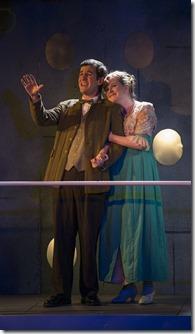
Titanic
Book by Peter Stone
Music and Lyrics by Maury Yeston
Directed by Scott Weinstein
at Theater Wit, 1229 W. Belmont (map)
thru Dec 7 | tickets: $34-$39 | more info
Check for half-price tickets
Read review
Big musical about a big ship works well in small package
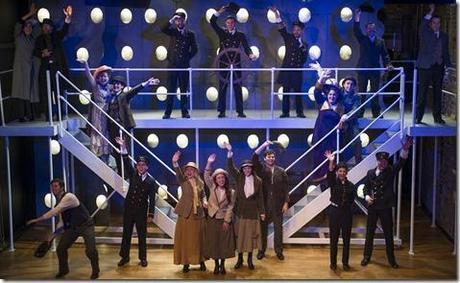
Griffin Theatre Company presents
Titanic
Review by John Olson
“How did they build Titanic?” sings a character early in this 1997 musical about the only voyage of the ill-fated luxury liner. It was an audacious enterprise, building this “floating city,” this unsinkable ship. On first blush, it sounded equally audacious to think of someone trying to stage this gigantic Broadway musical in one of Theater Wit’s 100-seat black boxes. The press materials tell us this chamber version of Titanic originated in Ithaca, NY’s Hangar Theatre in 2012 and also played in London’s Southwark Playhouse, so it’s been done before, but a little research suggests those earlier venues are at least twice the size of any of Theater Wit’s three spaces. Well, director Scott Weinstein and his design team found a way to do it in such a small venue and while there are a few distractions in knocking the piece down to size, their ingenuity makes it work.
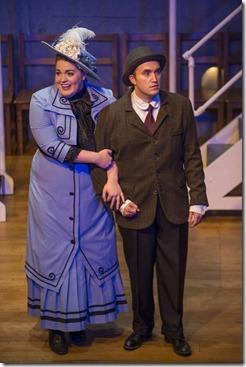
The original cast of 47 in the Broadway production has been reduced to 20 for this chamber version, and on a stage this size, that still looks like a lot. It works because 20 is enough to cast all the major roles without double-casting. True, the actors appear as ensemble members as well as playing their principal roles, and you may notice, for example, an actor playing a steerage class passenger sing and dance as a first class passenger later. The only real distraction, though, is a bit in which a single actress plays a number of first class passengers in the boarding scene early in the show. She changes poses without exiting and re-entering to signify different passengers. It’s a meta-theatrical bit that doesn’t fit the rest of the staging, but this is only a momentary distraction.
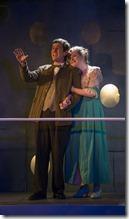
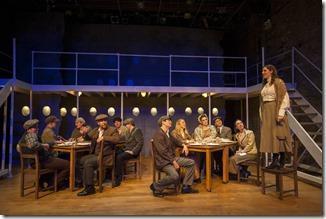
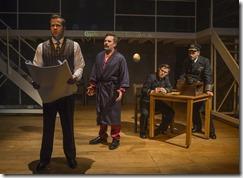
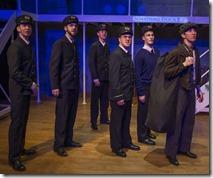
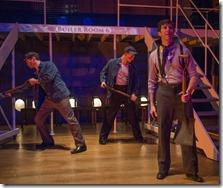
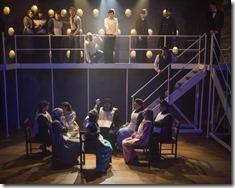
This Griffin Theatre production brings in many of Chicago’s strong pool of non-Equity musical theater performers to sing Maury Yeston’s grand score, and they do it justice. I attended the second to last preview (as Griffin opened up some of the previews to accommodate the interest from reviewers), and a few things vocally were a little rough. Some of the soloists struggled briefly with vocal range at points, and the balance between singers and the five-piece orchestra was sometimes off. Most significantly, between the balance issues, the English and Irish accents and the density and pace of some of Yeston’s lyrics, it was often hard to understand the lyrics. Weinstein’s pacing generally felt rushed in the first act as well. Presumably this has all been fixed by now.
Yeston and Peter Stone created an unusual musical, one with lots of characters but little plot except for the well-known details of the weather conditions, business decisions and plain bad luck that led to the ship’s sinking. Characters aren’t deeply developed, but rather represent the three fare classes of passengers aboard Titanic – and their analogues in onshore life as upper, middle and lower classes. As elsewhere in life, the rich have advantages that keep more of them alive (though many of the First Class males perished in the sinking as well, due to the “women and children first” philosophy of the time). In spite of the advantages of the rich, the story reminds us that we’re all mortal. Perhaps the Titanic is a metaphor for our planet or life itself. If one doesn’t buy into that symbolism, Titanic is still moving as an expression of the hope and optimism all the passengers shared in looking ahead at the possibilities of a new age and the promise of America. Yeston’s gorgeous music gives voice to these feelings with its period mix of styles from concert hall classicism through English music hall and ragtime. The new orchestrations by Ian Weinberger are satisfying, but in a perfect world, Yeston’s music deserves a big orchestra behind it. Regardless, this intensely humanistic piece hasn’t been performed a lot since its two-year run on Broadway and it deserves to be seen, heard and remembered. There are hopes this chamber version will make Titanic more affordable to produce and keep it alive in the canon of 20th Century musical theater.
Rating: ★★★½
Titanic continues through December 7th at Theater Wit, 1229 W. Belmont (map), with performances Thursdays-Saturdays at 7:30pm, Sundays 3pm. Tickets are $34-$39, and are available by phone (773-975-8150) or online through TheaterWit.org (check for half-price tickets at Goldstar.com). More information at GriffinTheatre.com/Titanic. (Running time: 2 hours 10 minutes, includes an intermission)

Photos by Michael Brosilow
artists
cast
Kelley Abell (Kate Murphey), Justin Adair (Fred Barrett), Neala Barron (Alice Beane), Joshua Bartlett (Charles Lightoller), Patrick Byrnes (Murdoch), Matt Edmonds (Charles Clarke), Nick Graffagna (Bellboy), Emily Grayson (Ida Strauss), Courtney Jones (Kate McGowan), John Keating (Henry Etches), Royen Kent (Harold Bride), Josh Kohane (Frederick Fleet), Eric Lindahl (Thomas Andrews), Scott Allen Luke (J. Bruce Ismay), Jake Mahler (Edgar Beane), Laura McClain (Caroline Neville), Christine Perkins (Kate Mullins), Kevin Stangler (Jim Farrell), Sean Thomas (Isador Strauss), Peter Vamvakas (Captain Smith).
behind the scenes
Scott Weinstein (director), Elizabeth Doran (music director), Ian Weinberger (orchestrations), Joe Schermoly (scenic design), Rachel Sypniewski (costume design), Brandon Wardell (lighting design), Christopher Kriz (sound design), Jamie Karas (properties design), Paul Deziel (projection design), Tyler Sawyer Smith (choreography), Adam Goldstein (dialect coach), Morgan Maher (dramaturg), Majel Cuza (production manager), Nate Lewellyn, Spencer Neiman (assistant directors), Katie Messmore (stage manager), Michael Brosilow (photos)
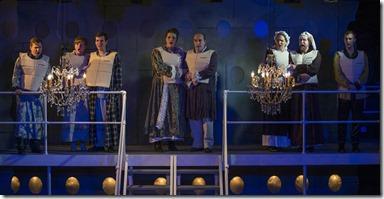
14-1049

